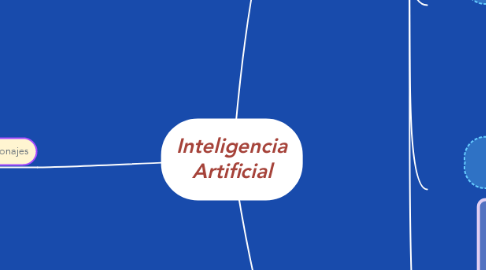
1. Personajes
1.1. David
1.2. Gigolo Joe
1.3. Monica Swinton
1.4. Henry Swinton
1.5. Martin Swinton
1.6. Teddy (Oso)
1.7. William Hurt
1.7.1. Training
1.7.2. Channels
1.7.3. International
1.7.4. Public Sector
1.7.5. Sales
1.7.6. Marketing Communications
1.7.7. Product Management
2. Ideas Principales
2.1. Hay una nueva clase de robots llamados Mecas, humanoides avanzados capaces de emular pensamientos y emociones.
2.2. Cybertronics de Nueva Jersey, crea un nuevo prototipo (David) es diseñado para parecerse a un niño y mostrar amor para sus poseedores humanos.
2.3. El hijo de los Swinton, Martín, fue puesto en animación suspendida hasta que se pudiera encontrar una cura para su rara enfermedad.
2.4. Un día se encuentra una cura para Martín y es llevado de vuelta a casa; aparece una rivalidad de hermanos entre Martín y David.
2.5. Mónica abandona a David y es capturado por la Feria de Carne (donde matan a los mecas por diversión).
2.6. David y Joe salen en busca del Hada azul, para que lo convierta en un niño de verdad
3. Desenlace
3.1. Dos mil años después la humanidad está extinta y Manhattan está enterrada bajo muchas capas de hielo glacial. Una nueva generación de Mecas más evolucionados y de aspecto alienígena humanoide que encuentran a David y Teddy
3.1.1. Situational Analysis / Drivers
3.1.1.1. What is driving us to do this?
3.1.1.2. SWOT Analysis
3.1.1.2.1. Strengths
3.1.1.2.2. Weaknesses
3.1.1.2.3. Opportunities
3.1.1.2.4. Threats
3.1.1.3. Customer Findings - What have we learned from customers?
3.1.2. Competitive Analysis
3.1.2.1. Do we have competitors and threats in these target markets with the proposed offerings?
3.1.2.2. What are our competitors doing and how are they positioning?
3.1.2.3. How do we position against each competitor?
3.1.3. Target Customer(s)
3.1.3.1. Buyer Profile
3.1.3.1.1. Title
3.1.3.1.2. Industry
3.1.3.1.3. Geography
3.1.3.1.4. Business Size
3.1.3.2. Influencer Profile
3.1.3.3. User Profile
3.1.3.4. What do customers want and need?
3.1.3.5. What business problems do each of these customers have?
3.1.4. Customer Segmentation
3.1.4.1. Which customers or sets of customers do we sell to?
3.1.4.2. What are the target market segments that we want to go after?
3.1.4.3. What are the distinct problems for each segment of the market?
3.1.5. Total Available Market
3.1.5.1. New Prospects
3.1.5.1.1. How much of each target segment have we penetrated?
3.1.5.1.2. How much opportunity is available in each target segment?
3.1.5.2. Existing Customers
3.1.5.2.1. Can we up-sell existing customers?
3.2. Atraves de los recuerdos de David, reconstruyen su casa
3.2.1. Service Offer
3.2.1.1. What are we selling?
3.2.1.2. Product Definition
3.2.1.3. Pricing
3.2.1.4. Packaging
3.2.1.5. Positioning
3.2.2. Value Proposition
3.2.2.1. What is the Value Proposition to the Customer?
3.2.2.2. What pain are we solving?
3.3. Por insistencia de David, ellos recrean a Mónica del ADN tomado del rizo de cabello que Teddy guardó.
3.3.1. Revenue Forecasts
3.3.1.1. Revenue and P&L Forecast (5 Years)
3.3.1.2. Revenue should be split out quarterly
3.3.2. Cost Analysis
3.3.2.1. Should include a description of the costs in entering this business and profitability analysis
3.3.3. Profitability Analysis
3.3.3.1. P&L for the offer to include gross margin, net income and break even analysis.
3.4. El clon solo puede vivir por un día y el proceso no puede repetirse. David pasa el día más feliz de su vida con Mónica y Teddy
3.4.1. Sales Strategy
3.4.1.1. Direct Sales Strategy
3.4.1.2. Inside Sales Strategy
3.4.1.3. Channel Sales Strategy
3.4.2. Partner Strategy
3.4.2.1. Channel Strategy
3.4.2.1.1. What 3rd party channels should we consider for reselling this service?
3.4.2.2. Technology Partnerships
3.4.2.2.1. What technology vendors (if any) do we need to work with to execute on this plan?
3.4.2.3. Solutions Partners
3.5. Go-To-Market Strategy
3.5.1. Positioning & Messaging
3.5.1.1. What is the key messaging and positioning for the service offer? (Pain, alternatives, solution)
3.5.1.2. How do we communicate internally?
3.5.1.3. How do we communicate externally?
3.5.2. Promotion Strategy
3.5.2.1. Marketing Programs (Installed base versus new prospects)
3.5.2.2. Advertising (Publications, etc.)
3.5.2.3. Analyst Relations (Target Analysts)
3.5.2.4. Public Relations
3.5.2.5. Events (Trade shows, SEO/SEA, Seminars)
3.5.2.6. Webinars
3.5.3. Demand Generation & Lead Qualification
3.5.3.1. How do we generate and qualify new leads for the target offer?
3.5.3.2. Prospect Lists
3.5.3.3. Key Questions to Ask
3.5.3.4. Sales Collateral
3.5.3.5. Presentations
3.5.3.6. Data Sheets
3.5.3.7. White Papers
3.5.3.8. ROI Tools
3.5.3.9. Other Sales Tools (web site, etc.)
3.6. Measure and Improve
3.6.1. Numbers, budget, waterfall, break-even (cost>leads>trials>deals)
3.6.2. Sales Programs
3.6.3. Accelerated Learning Strategy, Controls, Metrics
3.6.4. Include feedback loops
3.6.5. Include financial metrics (definition of success)
3.6.6. Pipeline reports, etc…
3.7. Other Considerations
3.7.1. M&A?
3.7.2. Risk Analysis & Mitigation

